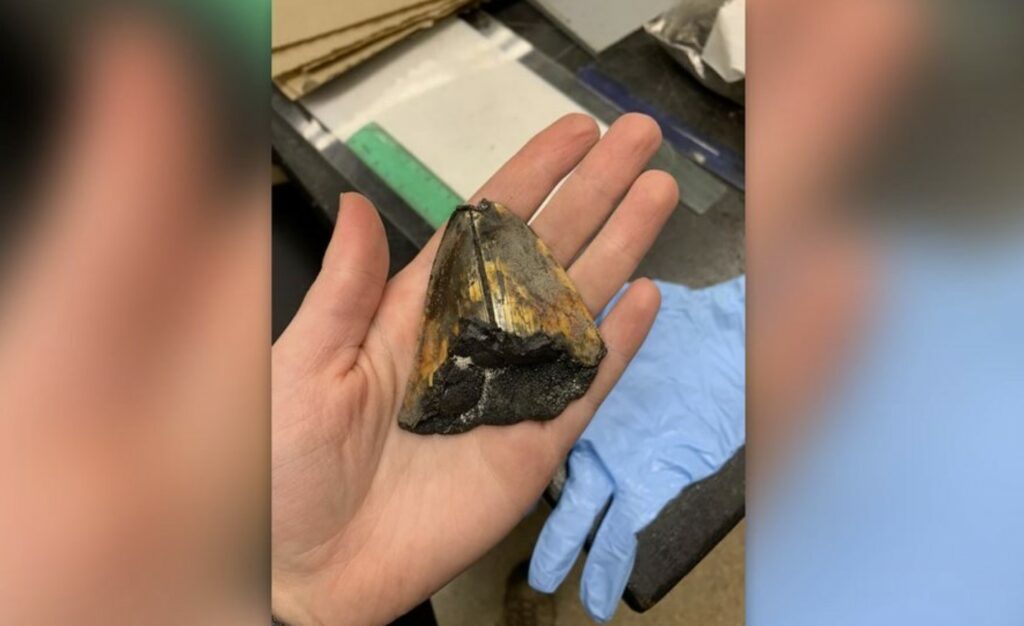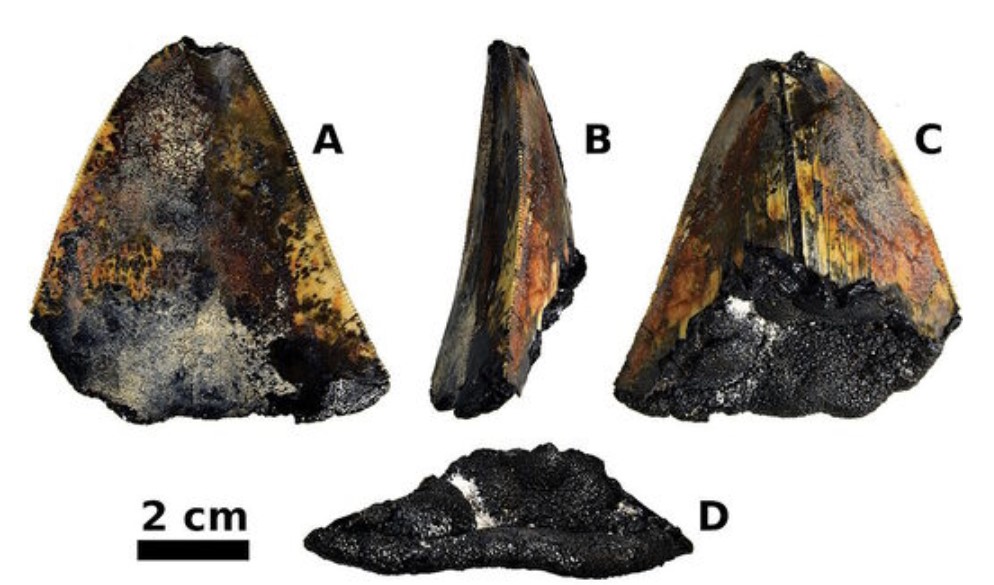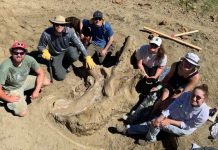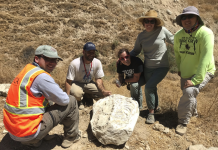
A remotely operated submarine was collecting samples on a previously unexplored deep sea mountain when it scooped up a rare megalodon tooth.
The gold-colored tooth, which is 2.7 inches (6.8 centimeters) long, was discovered more than 10,000 feet (3,090 meters) below the surface near the Johnston Atoll in the Pacific Remote Islands Marine National Monument, around 800 miles (1,300 kilometers) south of the Hawaiian Islands.
Researchers described the find in a study published Dec. 14 in the journal Historical Biology. The Ocean Exploration Trust, which led the 2022 expedition that found the tooth, has now released video detailing the events.
The discovery is the first in-situ observation and sampling of a megalodon tooth in the deep sea, meaning researchers found the fossil in its original resting place. Most deep-sea fossils are collected by dragging nets along the ocean floor, so researchers miss out on important information such as their precise location, according to a statement released by the Ocean Exploration Trust on Jan. 4.
Study co-author Nicolas Straube, an associate professor at the University Museum of Bergen in Norway, described it in the statement as an “amazing find.”
“The fossil was discovered at a very remote deep-sea locality from which megalodon fossils are rarely documented,” Straube said.

Megalodon (Otodus megalodon) was the largest shark to have ever lived, growing up to at least 49 feet (15 m) long and potentially up to 65 feet (20 m) long. The massive predators were top of the ocean food chain from around 20 million years ago until their extinction around 3.6 million years ago.
Megalodon teeth are relatively common fossils — each megalodon had around 276 teeth, and they lived in oceans around the world. However, most of these fossils are discovered on land near shorelines or rivers rather than in the deep sea, which is rarely explored, according to the statement.
Researchers aboard the Ocean Exploration Trust’s Nautilus exploration vessel were collecting samples around the Johnston Atoll in June 2022 to study its deep-sea geology and biology. They deployed a remotely operated vehicle (ROV) called Hercules to film and collect the samples, which were then sent to the University of Rhode Island for processing.
There, researchers found the tooth in one of the samples and suspected it came from a megalodon. Study co-author Dave Ebert, a researcher at the Moss Landing Marine Laboratories in California, later confirmed the tooth came from a megalodon.
Upon reviewing the video recorded by Hercules, the researchers also realized the tooth was visibly sticking out of the sand on the seamount before the ROV shoveled it up. Discovering an in-situ tooth on a deep-ocean mountain, or seamount, helps researchers learn more about the gigantic shark’s ocean habits.
“This fossil provides us with important insights into the distribution of megalodon,” study first author Jürgen Pollerspöck, a researcher at the Bavarian State Collection of Zoology in Germany, said in the statement.
“The sample indicates that megalodon was not a purely coastal species and that this species migrated across ocean basins similar to many modern-day species such as the great white shark.” [Nature]
Hey friends, it’s time to wake up!
If a few more people choose to support my work, I could expose more lies, root out more corruption, and call out more hypocrites. So, if you can afford it, please support my endeavor by either using PAYPAL or the DonorBox below (PAYPAL & Credit Cards / Debit Cards accepted)…
If you are a crypto fanatic, I do now accept crypto donations:
BTC: 1AjhUJM6cy8yr2UrT67iGYWLQNmhr3cHef (Network: Bitcoin) USDT: 0x490fe5d79d044a11c66c013e5b71305af0a76c1b (Network: Etherum ERC20)
You should join my newsletter to get a daily compilation of different breaking news, pictures and videos… YOU WILL LOVE IT!
Thank you,
Manuel













Sunny, I replied to you, it seems to not have posted underneath as usual. Maybe it will after moderation.
Joey
I think the same thing! There’s been interesting video, yes, I know a lot of hoaxes happen, however, the few I’ve seen would be extremely difficult to fake. Along with one being a Coast Guard rescue video that I’d be surprised if the Coast Guard would be as dishonest as that. I’d hope not any way! They were rescuing a sole survivor, in rough seas, of an overturned vessel, while the chest camera of the linemen was looking down watching the man being lifted up you could very distinctly see a massive black, shadow swim nearby. Not a normal sized shark by any stretch!
There was a found camera with video from a another fishing vessel that had been attacked by something off of the coast of South Africa years ago that in the part restored, showed this vessel being hit several times hard! It was a night trip. Major chaos. At one point as the boat sank, people were in the water, you can very faintly hear someone scream SHARK! The bodies of the four people were never found. Nothing except what sank with the boat in about 40 ft in water near the cliff off an inlet shore they were anchored in. THAT turned my stomach! I believe these scientists and biologists, etc. are sadly mistaken to believe these sharks no longer exist. The water on this planet is far too vast, deep, and mostly all unexplored! There’s NO WAY they can say with certainty that it doesn’t exist! More than likely many more! To do so would be ignorant. With the Greenland shark able to survive upwards to 600 years, it’s yet another reason. We certainly won’t get into the animals deemed extinct “millions” of years ago that have been discovered in our lifetime. This is a CREATED world! Not one that came from nothing! Thankfully prior evolutionists are figuring this out as well! Darwin was more than off of his rocker. It’s just a shame he and his followers believed the deception.
Joey sorry I didn’t catch your post sooner.Yes there is something out there.Most of the ancient mariners drew what they saw and even where they saw the creatures.Great numbers of the drawings were proven true have been studied and named.Its only been in the last 20 years we filmed a gigantic octopus.
There are other creatures from the drawings yet undiscovered scientifically.We also discovered the megamouth shark in1976.Its a big shark.Also far more recent is the beards baked whale.
Open ocean predators feast on pelagic fish octopus and last but not least prey on a diurnal cycle.
Going from deep water in the day to the middle top zones at night.No reason it couldn’t wouldn’t be able to feed.Very good reason it’s not recorded.I liken it to terrestrial animals in one sense.People who live in rural isolated areas occasionally see animals who they consider very deep wooded creatures.
Megladon may be the seas equivalent.
I should have prefaced this post.
There are higher strandings due to strikes disease acoustics than before.Partially expected.The number still seems high(especially ship strikes)There are reports of missing fins tails on basking sharks whale sharks and some whales.These are being found in areas not known for finning at all.In several places this would be the last thing the fisherman would do.They would be endangering themselves.Wouldnt be done unless they were starving to death.However this was a method of megladon.
They have also proved they could regulate their body temperature as well.Might not be extinct at all.Tracking tags from a large white shatk determined it had been eaten.
Very large shark filmed.Claimed to be pacific sleeper shark.Orcas other whales sharks beaching themselves.Orcas attacking boats around the straits of Gibralter off the coast of spain.Great whites do inhabit the mediterrain.Also the current their is such that warmer fresh water flows out and colder denser water
flows in.Also pretty deep water 3000 plus feet.Good hunting for very large predators.Fishetmen (aroung the world)over the years have sighted huge sharks not mistaken for whale or basking
sharks.Port Stephen’s 1918 was one such sighting.
There is something large and carnivorous
slowly showing itself.Megeladon or maybe it’s decendant.